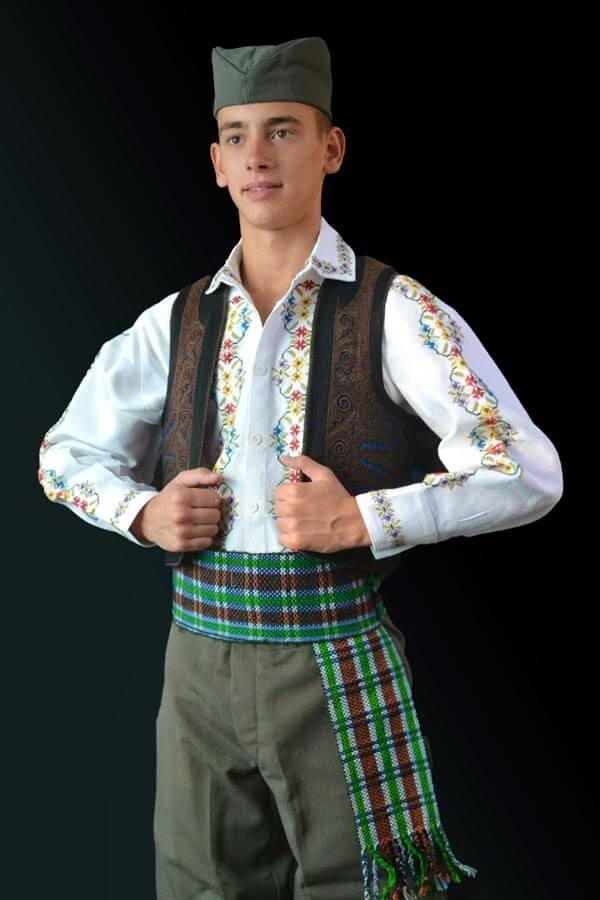Regardless of how informed a foreigner is, if he doesn’t know the origin and essence of the Serbian folk cap – the šajkača – he will never understand the locals. Namely, the šajkača is much more than a cap; it is a form od defiance, courage, tenderness and spite. For several centuries it has protected the heads of Serbian people from natural disasters and defeats in war. It presents a holy tie to the past and a bond to life.
During dangerous and hard times, the Serbian folk cap regains its fashionable status while hats, baseball caps and French berets sink into oblivion. The šajkača, an unavoidable part of a folk costumes during times of peace, is the only cap in the world that becomes a part of military uniforms in times of peace, always tend to look a bit like they’re at war.
The character of this cap is best witnessed by the fact that the šajkača is never taken off, except before Our Lord in church! People eat and work with this cap on their heads, adn when sleeping men keep it pulled over their faces to protect themselves from flies and to create an artificial night.
Why Šajkača?
The cap originates from the 15th century when it was worn by boatmen who moved in rowboats with sharp iron bows to intercept Turkish ships on the Danube and Tisa rivers, a practice that continued for centuries. Though the homemade šajak-čoja, a type of heavy cloth similar to coarse woolen fabric, originates from a Turkish word, the word čajka means seagull in Russian and it is no surprise that the šajkača represents, in fact, the stylised shape of this most poetic bird.
 No cap in the world so readily reveals the character of the man who wears it on his head! Pulled down to the eyebrows, the šajkača sends a signal of danger and the necessity of being on guard; also, it can reveal the hot-tempered character of its owner. Tilted sideways towards the ear, it discloses its owner’s bachelor mood and a tendency to drink and make merry; a readiness to surrender to exaggerated feelings, recalcitrance and grief.
No cap in the world so readily reveals the character of the man who wears it on his head! Pulled down to the eyebrows, the šajkača sends a signal of danger and the necessity of being on guard; also, it can reveal the hot-tempered character of its owner. Tilted sideways towards the ear, it discloses its owner’s bachelor mood and a tendency to drink and make merry; a readiness to surrender to exaggerated feelings, recalcitrance and grief.
Should the owner tilt it towards the back of his head, then we see a hidden ruffian or a confused man who is getting ready to do very hard work.
The oversized šajkača, which falls over the ears, tells us that its owner is negligent, that he gave up and reconciled to poverty and approaching misfortune. God, how many varieties of šajkača there are in Serbia! Wrinkled, sweaty, greasy, faded from rain and wind, heat and snow; brand new šajkača (worn on patron saint’s-day feasts or just for spite), insolent and staight ones, as if inflammatory, and there are those collapsed from grief and sadness which cover the head like a dejected bird.
Freshly laid eggs and picked pears are carried in it for guests from the city. When there is nothing else, the šajkača is used for scooping water from a spring.
Beads of sweat on the forehead are wiped with the šajkača in the field.
This cap with its double sides, which can be pulled down over the ears in winter, is also convenient for holding things; a flower in summer or a cigarette that will be smoked later.
A long awaited letter from a son in the army is stuck into it, to be seen by the whole village. Also, court summonses.
During war, a needle and a ball of thread are placed in the šajkača should a button fall off one’s overcoat.
Where should a lottery ticket be but in the šajkača!
When we are making merry, we put large bills into the Dragačevo trumpeters’ šajkača!
Of course, we put coins into it for beggars in front of church.
Anyhow, the šajkača is the most tolerant cap on the globe; it tranquilly puts up with other caps that conspire against the head it covers.
Regardless of the badges that are put on it – it is most beautiful without any emblem.
This is because the šajkača is far older than politics.
And wiser. And more durable. More lasting…
It does not fit with an urban suit and does not go well with sunglasses.
It is a sad thing to see in a souvenir shop.
For a half century, the šajkača patiently put up with the terrorism of Tito’s caps, whose shapes resembled caps from foreign armies and police forces.
Those caps are so unnatural and so ugly on the heads of our soldiers that they would take them off at the first available opportunity so as not to ruin their hair; they were usually seen stuck under the belt. There was also the famous three-horned cap – about which there is a song:
I am Anka a partisan
I wear a three-horned cap
And I fight against God!
In contrast to this blasphemous cap and its kin, the šajkača can only be Orthodox. It is not even taken off before the king, with whom the Serbian yeomen were on per tu from time immemorial!
The only bad trait of the šajkača is that during times of peace and prosperity it turns into a hat and easily forgets itself.
Those who wear it consistently are the salt of this country..
Excerpt from book “A Guide to the Serbian Mentality” by Momo Kapor